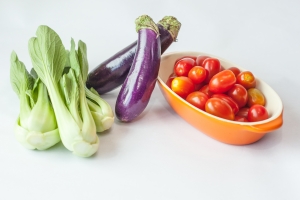Are you interested in loosing weight or just staying in shape??
Eating green vegetables are filling, extremely nutritious and very low in calories. In the amounts commonly consumed, green leafy vegetables provide an abundance of roughage or fiber, which is an important component of a healthful diet. The greener the leaf, the higher the carotene content. Carotene from leafy vegetables is more readily absorbed and utilized than that from yellow ones. Fresh vegetable leaves are also good sources of vitamin C, unfortunately, much of this ascorbic acid is often lost before consumption, through oxidation and leaching during preparation. Though little carotene is lost in cooking, portions of water-soluble vitamins and appreciable quantities of iron, magnesium, and phosphorus may be lost if the cooking water of leafy vegetables is discarded.
On a calorie by-calorie-basis, green vegetables contain significantly more fiber than whole grains. As an example: 2 slices of whole-wheat bread –about 140 calories, 4 gms of fiber, 140 mgs of potassium vs 2 cups of broccoli—87 calories, 9 gms of fiber, 1,000 mgs of potassium.
Although it is recommended to consume a minimum of 25-30gms/day the average American consumes 15 gms of fiber/day. Diets low in fiber may underlie or exacerbate constipation, appendicitis, hemorrhoids, deep-vein thrombosis, varicose veins, diverticulitis, hiatal hernia and gastroesophageal reflux. Fiber is thought to help prevent colon cancer, diabetes and heart disease. Fiber is found abundantly in green vegetables.
Promoting good health includes the necessity to eat potassium-rich foods which are green vegetables and fruits primarily, as well as animal protein and potatoes. Research recommends 7,000-11,000mg of potassium/day which should come from your diet. However, the average American consumes about 2,500mg/day. Diets low in potassium include diseases as high blood pressure, strokes, kidney stones, osteoporosis, gastrointestinal tract cancers, asthma, and insomnia.
In addition to containing high levels of fiber and potassium, green vegetables also contain an abundance of phytochemicals (bioflavenoids and carotenoids) which are known to offer a number of disease-fighting benefits. Over recent years of research, it has been concluded that we need to ensure adequate intake of fruits and green vegetables so we can reap the benefits of phytochemicals.
GREEN NOTES
Swiss Chard, Kale & Spinach are full of inflammation-fighting antioxidants and can be prepared in many ways. Add them to your salads or soups or steam with herbs. Due to their high levels of Vitamins A, C & K, they protect your brain from oxidative stress. These three green vegetables are tasty treat at any dinner table.
Bok Choy is not only a powerhouse of vitamins and minerals but contains more than 70 antioxidant substances that scavenge free radicals. Add it into salads or soups, roasted in the oven or braised with garlic, herbs & mushrooms. This green vegetable is a delight in Asian dishes!
Peas—packed to the pod with vitamins and minerals, peas are particularly high in nutrients as: vitamin K, C, B1, manganese and dietary fiber. These little green vegetables are awesome in potato or mac salad!
Bell peppers—red, yellow or green, bell peppers provide: vitamins A, C, E, K and B6 and a great source of antioxidants. The skin is a good source of bioflavonoids. Green bell peppers add color and flavor to any gluten free pizza. Green vegetables like arugula also is a great healthy pizza topper.
So, what are you waiting for?
Wear your GREENS DAILY
Not only for St Patrick’s Day!!!
Iris Rosenfeld. DC
23121 Plaza Pointe Drive Suite 150
Laguna Hills, Ca 92653
949-380-7215
[email protected]





